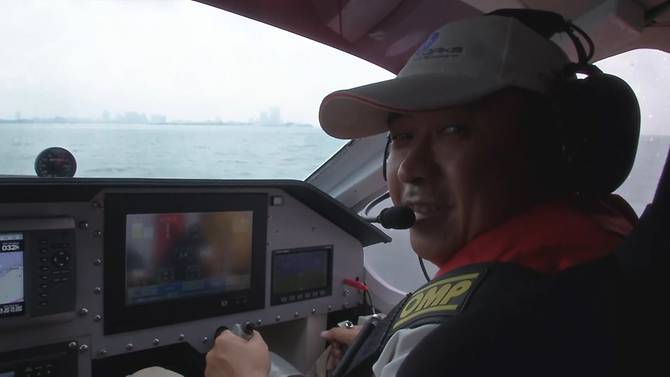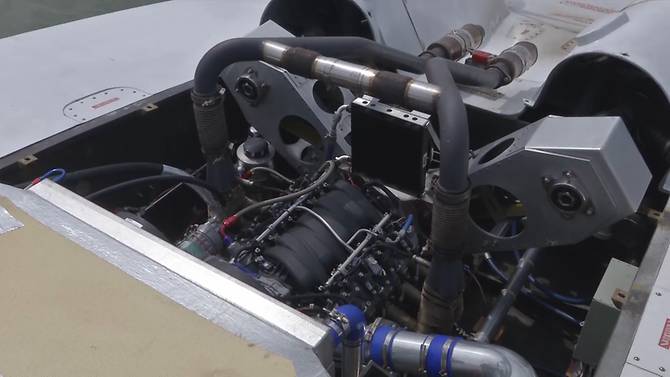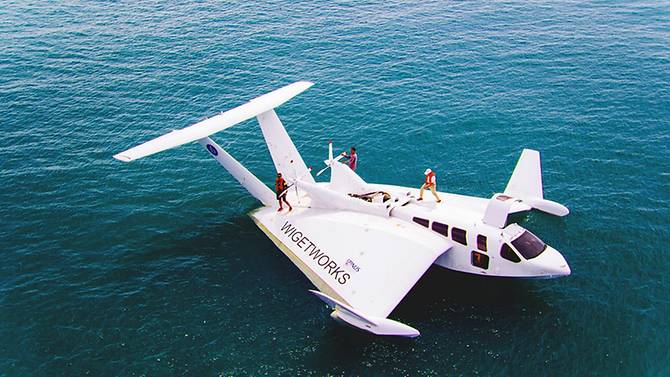MALACCA: When you are on this craft, you’ll notice its aerodynamic fuselage, sleek wings, twin propellers and how it flies effortlessly – much like an airplane.
But the Singapore company behind it will impress upon you that the peculiar looking Airfish 8 is not an airplane, but a ship.
This enigma of a craft could soon revolutionise the way people travel, especially from island to island, if Wigetworks has its way.
Executive director Kenneth Tan called it a “disruptive innovation”, describing how the craft, which is powered by a V8 engine (used by racing cars), flies some 6m above water and doesn’t require a runway or an airfield to land since it docks on water.
This means it can reach places where airplanes are unable to access or ferry boats won’t go.
The Airfish 8, based on a German prototype, is the first in the world registered as a merchant ship under the Singapore Registry of Shipping, Mr Tan said.
“There are a lot of islands that do not have the funding to build infrastructure to take light aircraft or even bigger aircraft.
“And there are islands that are too far away, whereby conventional ferry travel could be too long. And these islands are, most of the time, left deserted,” he told the programme Money Mind. (Watch the episode here.)
“With this craft, we’re breaking into new frontiers, reopening up all these islands for future development.”
CHEAPER, BETTER, FASTER
This craft uses a Wing-In-Ground (WIG) Effect phenomenon where it flies close to the water surface by using a cushion of high-pressure air between its wing and the water surface – akin to floating on a cushion of air.
And it travels much faster than conventional boats or aircraft while using less power, said Mr Tan.
“It effectively provides a very safe, fast and comfortable ride as well as a very economical mode of transportation from place to place.
“And if anything goes wrong, the runway is only metres above the water,” he pointed out.
WATCH: So new, they wrote the manual on it (2:15)
The Airfish runs on petroleum, which is cheaper than aviation fuel. And you don’t need a pilot’s permit to fly this eight-seater craft since it flies so low.
It can go up to 150km an hour, some two to three times faster than most ferries.
“The best way to describe it is like we are skimming over the water, like a bird trying to reduce its energy, flying as low as it can,” said Wigetworks’chief WIG training captain Syed Abdullah.
Mr Tan said that besides the tourism sector where the Airfish 8 can be used to ferry passengers from resorts to island destinations, the craft could also be used in the oil and gas, coastguard and maritime security sectors.
“The other interesting sectors would be law enforcement and medical evacuations where they can make full use of the speed and the lower operating costs, to help in safety and prevent illegal activities,” he said.
He hopes to use Singapore as a springboard to market the Airfish 8 to the rest of the world, and he mentioned that they recently hosted a delegation from Spain keen on using this craft for inter-island transfers.
BUILDING BIGGER CRAFTS
The Singapore company relocated its operations to Malacca as it needed more sea space for flight demonstrations and to train new captains.
It had embarked on a research and development collaboration with the National University of Singapore on the WIG technology several years ago, with the support of the Maritime and Port Authority of Singapore which co-funded the research programme.
“The findings have been very positive and we look forward to building a larger craft, maybe a 20 to 50-seater WIG craft. We are also actively looking for additional funding,” he said.
Mr Tay Yong Kang, associate director of management consultancy firm ICF, sees the potential in this craft, citing that small planes often face the problem of cost, where the cost per seat is very high.
“Some of the vessels today with this technology would be able to transport passengers at a much lower cost and I can definitely see some potential there. Obviously there are still some challenges and hurdles. I think the technology is still a little young,” he added.
Mr Tay for instance questioned the aspect of passenger comfort, especially when there are choppy waters and strong waves. He noted that seaplanes face problems during landing and take-off in bad weather.
“I would imagine this is a similar problem that vessels with this (WIG) technology would face. Those are some of the concerns that would have to be thought through and worked on,” he said.
Watch this episode of Money Mind, ‘Pushing The Boundaries’.
Read more at http://www.channelnewsasia.com/news/cnainsider/riding-the-airfish-singapore-company-hopes-to-make-it-a-travel-9033908


